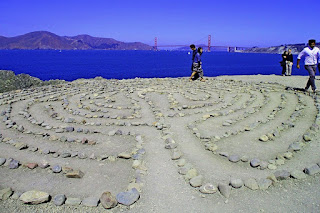Photograph by Reverend Steve Waites
The Hopi Indians of North America had a symbol for Mother Earth known today as the "Classical Seven-Path Labyrinth." It was this symbol of the Mother which identified the sacred in nature - that spiraling form found throughout nature. Labyrinths were woven into objects to personify man's connection to his source and were often placed at sacred places in nature to remind him of this union. When one walks the labyrinth it is in recreating this very ancient expression of thanks and remembrance of the divine in all things. http://www.labyrinthina.com/path.htm.
The labyrinth is, so to speak, the counter-image of the primal yearning for the cave. It is the image of that other primal yearning for greater awareness, and it is always an expression of the possibility of advancing rather than returning into unconsciousness and timelessness. For if the cave is dark, then the labyrinth is dimly lit. If the cave is an expression of remoteness from consciousness, a symbol of unconsciousness, then the labyrinth is a way, if still a confused way, into awareness.
-- from "Cave and Labyrinth" by Jean Gebser, Parabola, Vol. XVII, Number 2, "Labyrinths," (May 1992).
-- from "Cave and Labyrinth" by Jean Gebser, Parabola, Vol. XVII, Number 2, "Labyrinths," (May 1992).
Labyrinths have been known to the human race for over 3,500 years, conjuring up such images as the legend of Theseus and the Minotaur. They have been used in many different religious ways by many peoples, and as solar and lunar calendars. In Arizona and the American Southwest the Hopi use a form of the labyrinth in their religious symbolism, and the Tohono O'odham "Man in the Maze" is actually a "seven-circuit" labyrinth and is part of an elaborate creation story..
The oldest existing Christian labyrinth is probably the one in the fourth-century basilica of Reparatus, Orleansville, Algeria. Christians used labyrinths on pre-Christian sites and modeled their own after ones used by earlier cultures. The development of the high medieval Christian seven circuit labyrinth was a breakthrough in design. Its path of seven circles was cruciform (shaped like the Cross) and thus incorporated the central Christian symbol. Use of these labyrinths flourished in Europe throughout the eleventh and twelfth centuries and beyond, especially in the French cathedrals of Chartres, Sens, Poitiers, Bayeaux, Amiens and Rheims and in the Italian cathedrals at Lucca and San Maria-di-Trastavera in Rome.
Medieval pilgrims, unable to fulfill their desire to make a pilgrimage to Jerusalem, went instead to many pilgrimage sites in Europe or Britain. In many cases the end of their journey was a labyrinth formed of stone and laid in the floor of the nave of one of these great Gothic cathedrals. The center of the labyrinths probably represented for many pilgrims the Holy City itself and thus became the substitute goal of the journey.
The Chartres Cathedral Labyrinth
The sacred geometry of the labyrinth involves the numbers four, seven and twelve, emerging out of the "paths" and "walls" themselves. The labyrinth is divided neatly into four quarters around a cross, standing in the medieval mind for the four gospels (Matthew, Mark, Luke and John) and also for the four stages of the Mass (Evangelium, Offertory, Consecration, and Communion). Labyrinth meditation might be based on one of these or some other set of four, assigning each quarter section to one, and so forth.
Seven is the number of 180 turns there are in each quarter of the labyrinth. This relates to the seven Liberal Arts of medieval education, the chakras of the human body, or perhaps the seven paths of the classic medieval cruciform labyrinths.
Twelve is the total number of the labyrinth's paths and center, thus relating it to the twelve-month calendar. The "lunations" around the outside of the labyrinth are a lunar calendar and can be used to determine, among other things, the date of Easter, which falls on the Sunday after the full moon that occurs on or after the spring equinox.
The six "petals" of the center of the labyrinth provide individual opportunities for symbolic representation and meditation. Moving clockwise from the entrance, they represent mineral, plant, animal, human, angelic and unnameable properties. In the very center of the Grace St. Paul's labyrinth, three consecrated hosts, representing the three persons of the Trinity, are embedded in the concrete inside a metal pix.
Walking the labyrinth models the classical three-fold spiritual path. Walking in: Purgation, emptying or letting go. Time in the center: Illumination, clarity, insight. Walking out: Union, initiative, integration, and action in the world. The sacred geometry of the labyrinth involves the numbers four, seven and twelve, emerging out of the "paths" and "walls" themselves. The labyrinth is divided neatly into four quarters around a cross, standing in the medieval mind for the four gospels (Matthew, Mark, Luke and John) and also for the four stages of the Mass (Evangelium, Offertory, Consecration, and Communion). Labyrinth meditation might be based on one of these or some other set of four, assigning each quarter section to one, and so forth.
The six "petals" of the center of the labyrinth provide individual opportunities for symbolic representation and meditation. Moving clockwise from the entrance, they represent mineral, plant, animal, human, angelic and unnameable properties. In the very center of the Grace St. Paul's labyrinth, three consecrated hosts, representing the three persons of the Trinity, are embedded in the concrete inside a metal pix.
Walking the labyrinth models the classical three-fold spiritual path. Walking in: Purgation, emptying or letting go. Time in the center: Illumination, clarity, insight. Walking out: Union, initiative, integration, and action in the world. The sacred geometry of the labyrinth involves the numbers four, seven and twelve, emerging out of the "paths" and "walls" themselves. The labyrinth is divided neatly into four quarters around a cross, standing in the medieval mind for the four gospels (Matthew, Mark, Luke and John) and also for the four stages of the Mass (Evangelium, Offertory, Consecration, and Communion). Labyrinth meditation might be based on one of these or some other set of four, assigning each quarter section to one, and so forth.
Walking the labyrinth models the classical three-fold spiritual path. Walking in: Purgation, emptying or letting go. Time in the center: Illumination, clarity, insight. Walking out: Union, initiative, integration, and action in the world.
As a part of my personal journey I have had the opportunity to walk several labyrinths; the Glastonbury labyrinth in England, the Angel Valley labyrinth in Sedona, Arizona, the Grace Cathedral labyrinth in San Francisco, California. Each time there were specific challenges in my life that needed light shed upon them and each labyrinth journey allowed me to move into a deeper meditation. Within the depth of the meditation the challenges took a different appearance that unfolded a new perspective. If you have the opportunity to experience the spiritual energy of the labyrinth, I certainly encourage you to do so.
Reverend Angela DeBry, D.D. S.T.L
Vice President and Dean of Education
reverenddebry@sacredfoundations.net
www.sacredfoundations.net






No comments:
Post a Comment